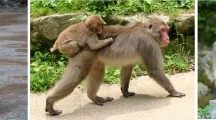Abstract
This study documents age-related changes in the interactions of wild-born cynomolgus macaque mothers and their infants living in individual cages during the first 14 weeks of infant life. Body contact between mother and infant, maternal holding, and infant sucking were found to decrease, and the mothers showed an increased frequency of aggression toward their infants with age. These results were broadly similar to those reported for mother-infant interactions in other macaques living in social groups. Nevertheless, a clear difference between the present cynomolgus macaques and other macaques in social groups was apparent. The cynomolgus macaque mothers tended to permit their infants to move about freely without displaying maternal protectiveness such as restraint or retrieval, unlike other macaque mothers in social groups. Such maternal behaviors might derive from the experience of living in individual cages for many years and the relative safety of living in individual cages. The lack of maternal restraint and retrieval could be responsible for the observed sex differences in behavior: male infants moved more actively, and broke, and made contact with their mothers more frequently than did female infants. Moreover, mothers of female infants held and groomed them more frequently and were less aggressive toward them.
Similar content being viewed by others
References
Altmann, J., 1974. Observational study of behavior: Sampling methods.Behaviour, 49: 227–267.
Berman, C. M., 1980. Mother-infant relationships among free-ranging rhesus monkeys on Cayo Santiago: A comparison with captive pairs.Anim. Behav., 28: 860–873.
————, 1982. The ontogeny of social relationships with group companions among free-ranging infant rhesus monkeys I. Social networks and differentiation.Anim. Behav., 30: 149–162.
Cho, F., K. Hanari, M. Suzuki, &S. Honjo, 1985. Relationship between fetal position and still-birth in the cynomolgus monkeys (Macaca fascicularis): Reproductive analysis.J. Med. Primatol., 14: 169–174.
————,M. Suzuki, &S. Honjo, 1986. Adoption success under single-cage conditions by cynomolgus macaque mothers (Macaca fascicularis).Amer. J. Primatol., 10: 119–124.
Eaton, G. G., D. F. Johnson, B. B. Glick, &J. M. Worlein, 1985. Development in Japanese macaques (Macaca fuscata): Sexually dimorphic behavior during the first year of life.Primates, 26: 238–248.
————, ————, ————, & ————, 1986. Japanese macaque (Macaca fuscata) social development: Sex differences in juvenile behavior.Primates, 27: 141–150.
Harlow, H. F., 1962. The heterosexual affectional system in monkeys.Amer. Psychol., 17: 1–9.
Hinde, R. A., 1971. Development of social behavior. In:Behavior of Nonhuman Primates, Vol. 3,A. M. Schrier &F. Stollnitz (eds.), Academic Press, New York, pp. 1–68.
———— &Y. Spencer-Booth, 1967. The behaviour of socially living rhesus monkeys in their first two and a half years.Anim. Behav., 15: 169–196.
Hiraiwa, M., 1981. Maternal and alloparental care in a troop of free-ranging Japanese monkeys.Primates, 22: 309–329.
Honjo, S., 1985. The Japanese Tsukuba Primate Center for Medical Science (TPC): An outline.J. Med. Primatol., 14: 75–89.
————,F. Cho, T. Fujiwara, Y. Yoshioka, M. Yabe, &Y. Noguchi, 1978. Breeding of cynomolgus monkeys through successive generations by indoor cage system.Jap. J. Med. Sci. Biol., 31: 301–310.
————, ————, &K. Terao, 1984. Establishing the cynomolgus monkeys as a laboratory animal. In:Advances in Veterinary Science and Comparative Medicine, Vol. 28, Research on Nonhuman Primates,A. G. Hendrickx (eds.), Academic Press, New York, pp. 51–80.
————,T. Fujiwara, &F. Cho, 1975. A comparison of breeding performance of individual cage and gang cage systems in cynomolgus monkeys. In:Contemporary Primatology,S. Kondo,M. Kawai, &A. Ehara (eds.), Karger, Basel, pp. 98–105.
Itoigawa, N., 1973. Group organization of a natural troop of Japanese monkeys and mother-infant interactions. In:Behavioral Regulators of Behavior in Primates,C. R. Carpenter (ed.), Bucknell Univ. Press, Lewisburg, pp. 229–250.
Koyama, N., 1985. Playmate relationships among individuals of the Japanese monkey troop in Arashiyama.Primates, 26: 390–406.
Mitchell, G. &E. M. Brandt, 1970. Behavioral differences related to experience of mother and sex of infant in the rhesus monkey.Develop. Psychol., 3: 149–159.
Nakamichi, M., 1989. Sex differences in social development during the first four years in a free-ranging group of Japanese monkeys (Macaca fuscata).Anim. Behav., 38: 737–748.
Rhine, R. J. &H. Hendy-Neely, 1978. Social development of stumptail macaques (Macaca arctoides): Synchrony of changes in mother-infant interactions and individual behaviors during the first 60 days of life.Primates, 19: 681–692.
Rosenblum, L. A. &I. C. Kaufman, 1967. Laboratory observations of early mother-infant relations in pigtail and bonnet macaques. In:Social Communication Among Primates,S. A. Altmann (ed.), Univ. of Chicago Press, Chicago, pp. 33–42.
Yoshida, T., Y. Gotoh, K. Narita, T. Shimizu, M. Nakajima, F. Cho, &S. Honjo, 1982. Management of the individual growth of infant cynomolgus monkeys (Macaca fascicularis) at the largescale breeding colony.J. Growth, 21: 12–19. (in Japanese)
Author information
Authors and Affiliations
About this article
Cite this article
Nakamichi, M., Cho, F. & Minami, T. Mother-infant interactions of wild-born, individually-caged cynomolgus monkeys (Macaca fascicularis) during the first 14 weeks of infant life. Primates 31, 213–224 (1990). https://doi.org/10.1007/BF02380943
Received:
Accepted:
Issue Date:
DOI: https://doi.org/10.1007/BF02380943




